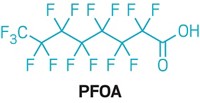Advertisement
Grab your lab coat. Let's get started
Welcome!
Welcome!
Create an account below to get 6 C&EN articles per month, receive newsletters and more - all free.
It seems this is your first time logging in online. Please enter the following information to continue.
As an ACS member you automatically get access to this site. All we need is few more details to create your reading experience.
Not you? Sign in with a different account.
Not you? Sign in with a different account.
ERROR 1
ERROR 1
ERROR 2
ERROR 2
ERROR 2
ERROR 2
ERROR 2
Password and Confirm password must match.
If you have an ACS member number, please enter it here so we can link this account to your membership. (optional)
ERROR 2
ACS values your privacy. By submitting your information, you are gaining access to C&EN and subscribing to our weekly newsletter. We use the information you provide to make your reading experience better, and we will never sell your data to third party members.
Persistent Pollutants
EPA sets limits for 6 PFAS in drinking water
Regulation will help protect 100 million people from exposure to ‘forever chemicals,’ agency says
by Britt E. Erickson
April 10, 2024

To help protect people from harmful per- and polyfluoroalkyl substances (PFAS) and ensure access to clean drinking water, the US Environmental Protection Agency has finalized tough new limits for six PFAS in drinking water. The standard, announced April 10, will “reduce PFAS exposure for approximately 100 million people, prevent thousands of deaths, and reduce tens of thousands of serious illnesses,” the EPA says.
For two of the most commonly found and most toxic PFAS—perfluorooctanoic acid (PFOA) and perfluorooctanesulfonic acid (PFOS)—the EPA set a limit of 4 parts per trillion each, the same level it proposed last year. The chemicals aren’t produced in the US anymore, but they were used in numerous consumer products for decades and still contaminate many drinking-water supplies.
For three additional PFAS—perfluorononanoic acid (PFNA), perfluorohexanesulfonic acid (PFHxS), and hexafluoropropylene oxide dimer acid (HFPO-DA, used in Chemours’s GenX product)—the EPA capped levels at 10 parts per trillion each. The agency also set a limit for mixtures containing at least two of the following PFAS: perfluorobutanesulfonic acid (PFBS), PFNA, PFHxS, and HFPO-DA.
Commonly called forever chemicals because they are slow to break down in the environment, PFAS are a class of more than 10,000 compounds known for their ability to repel grease and water. Little is known about the toxicity of most of them, but those targeted by the EPA’s new drinking-water standard “have been linked to serious illnesses, including cancer, liver damage, and high cholesterol,” EPA administrator Michael Regan said during a press briefing. “With today’s action, we are one huge step closer to finally shutting off the tap on forever chemicals once and for all.”
The EPA’s action on PFAS in drinking water is “the most consequential and difficult decision to protect drinking water in the past 30 years,” Ken Cook, president of the Environmental Working Group, an advocacy organization, said at the press briefing. “This was a big, tough decision.”
The EPA estimates that complying with the rule will cost the drinking-water industry $1.5 billion. But the American Water Works Association, a water industry group, says the actual cost will likely be three to four times as high, and much of the burden will fall on small water systems.
The chemical industry also opposes the rule. “Since this proposal was first announced, new real-world data has become available through national monitoring that confirms the rationale for this proposal is based on inaccurate and out-of-date information,” the American Chemistry Council, which represents chemical makers, says in a statement. “Failure to incorporate this data into the final rule means that the number of small water systems that will be impacted by the new standard is three times higher than EPA estimated, forcing them to divert critical resources away from other higher-priority drinking water needs.”
The new rule gives public water systems a total of 5 years to comply with the limits—3 years to test their water for the six PFAS and 2 years to install technology to treat the water if needed.
The EPA estimates that 6–10% of the 66,000 public water systems in the US will need treatment technology to comply with the rule. The actual number will become clearer once water utilities provide PFAS monitoring data to the EPA. The US Geological Survey estimated last year that 45% of tap water in the US is contaminated with at least one member of the PFAS family.
To help pay for initial monitoring costs, the EPA will provide $1 billion in funding for states to test drinking water, including in private wells, for PFAS. The money is part of $9 billion provided by the Bipartisan Infrastructure Law to address emerging contaminants like PFAS in drinking water.






Join the conversation
Contact the reporter
Submit a Letter to the Editor for publication
Engage with us on Twitter